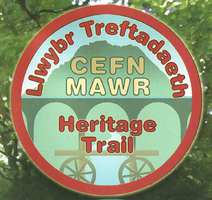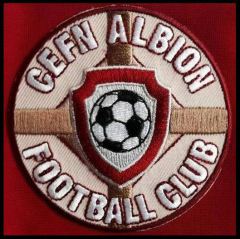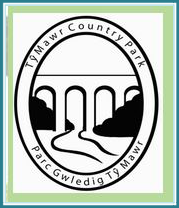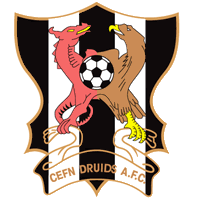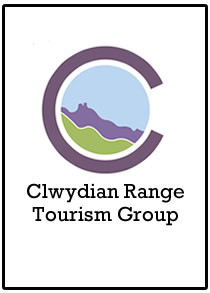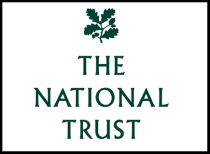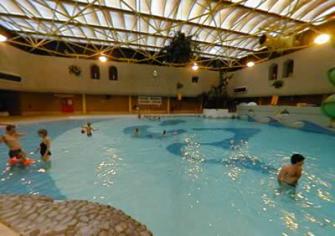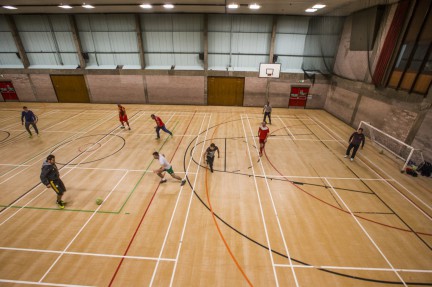Plas Madoc LL14 3HL
Plas Madoc is an area of the Cefn next to Cefn Mawr in the Pontcysyllte World Heritage Site and is best known today for its Leisure centre first built in the early 1970’s. This excellent facility has many attractions for lots of people and is very popular with the local community. So much so that when it was closed by in 2014 the local community banded together and reopened it. Well done every one and is now operated by the Splash Community Trust.
Since then it has continued to provide much needed sports facilities for lots of people in North East Wales as well as our own local people. It has ……….
Plas Madoc Leisure Centre Fitness and fun for all the family! Plas Madoc Leisure and Activity Centre situated less than one mile from Cefn Mawr village centre and the proposed site of the new marina at the rear of the Queens Hotel. This is only five minutes on the regular bus services already running. It is a regional leisure centre facility and attracts users and visitors from all over the North West, Shropshire and North Wales. Plas Madoc is renowned for its Leisure Pool 'The Tropical Lagoon'. It is the perfect place for the family to have FUN. Walk along the surf, climb on the crocodile, slide down the elephant and the snake or play in the waves. 'The Lagoon' is ideal for families with young children as they can play in the shallow water on the 'beach'. It is a great place to learn to swim and classes are provided at all levels by their trained staff.
The Sports Hall is multi-purpose and a great venue for everything from mixed martial arts and circuit training through to ladies’ fitness and table tennis. It all happens at Plas Madoc! The centre has 2 squash courts, 4 badminton courts and indoor football – they are all available at Plas Madoc Leisure and Activity Centre.
The fitness suite has a full range of CV, resistance and free weight equipment supplied by Technogym. All CV equipment has touch screen controls, on board TV, radio, interactive games and iPod docking facility and is simple and easy to use. All you need is your own pair of earphones and you can listen to your favourite programme or your own music selection whilst exercising! If you want to lose some weight, get a little fitter or have aspirations to compete at the highest level in your chosen sport, the male and female instructors can offer programmes to suit your lifestyle, goals and ambitions.
Climbing Wall, come and keep your hand in over the wetter days of winter for the seasoned climbers, or as beginners, classes are run that are just good fun, it is up to you and all in a safe, friendly warm and dry environment.
Sauna and steam rooms relax and unwind in the mixed facilities. The sauna is set at a sweltering 90°, it’s the perfect place to relax after a workout, whilst, the steam room has a eucalyptus scent to open airways. The area also has a large relaxation area where you can sit and socialize in a calming environment.
Plas Madoc Leisure Centre is now run by Splash Community Trust who saved the centre from closure back in December 2014. Plas Madoc Really does offer "Fun for the whole Family!"
If you're visiting North East Wales or the Pontcysyllte World Heritage Site why not call in? Visit our website www.plas-madoc.com or call 01978 821 600 for more details."
Plas Madoc Leisure Centre , Llangollen Road, Acrefair, Wrexham, LL14 3HL
Splash Community Trust, Plas Madoc Leisure Centre, Telephone 01978 821 600.
The Shops of Plas Madoc
But Plas Madoc is also an area of the Cefn and there is more to it that just the sports centre. There are several shops the other facilities …….
Plas Madoc Post Office & Shop. This handy little convenience store and post office is situated just to the rear of the Plas Madoc Leisure Centre, and is open every day most hours, 4 Woodwards Walk, Acrefair (Plas Madoc), Wrexham, Clwyd, LL14 3UY, Telephone: 01978 820 729
Alexander’s Pharmacy & Chemists with an extensive range of products and a prescription service.
Alexander's Pharmacies Ltd 52 - 53 Peris, Plas Madoc, ACREFAIR, Wrexham, LL14 3LF
Telephone: 01978 810272 Fax: 01978 810272
E-mail: alexanderspharmacy@yahoo.co.uk Website: www.alexanderspharmacy.com
The Plas Madoc Lesiure Center before closure by WCBC in 2012 and the construction of the new Plas Telford Care Home. This car park was initially the site of a new shopping complex built in the 1970s with the new Plas Madoc Estate but was later demolished in the 1980’s and turned into the car park as seen before the construction of the new Plas Telford House which now occupies the site. This was a classic case of mixed use development by the council that did not work. So we ask WCBC to think carefully before we get any more.
Some Plas Madoc History
The Plas Madoc Estate and Leisure Centre take the name from the previous country hall that once stood on the grounds of the Plas Madoc Park which they are now built on. The Plas Madoc Hall was a large country house, much larger than the Plas Kynaston Hall of the neighbouring country estate.
Although the Plas Madoc Hall was demolished in the 1960’s to make way for the new Plas Madoc Council Housing Estate the Plas Kynaston Hall still stands in the middle of Cefn Mawr today in 2017.
The oldest record of a house at the site dates back to 1455 and the family name of Madoc ap David ap Llewellyn ap Ednyfed. It is believed the original house was a half-timber building. By 1620 the Plas Madoc Hall & Estate covered over 232 acres of land between the Wynstay and Plas Kynaston Estates and was inherited by Edward Lloyd whom was a Coroner for the County and decedent of Madoc family. The Plas Madoc Hall & Estate remained in the same family line through a succession of inheritances until the mid-1800’s when Gorge Hammond Whaley became the owner.
The date of construction for Plas Madoc Hall was not known but since it was built in the Georgian style of architecture that was current during British monarchs of the House of Hanover—George I, George II, George III, and George IV—who reigned in continuous succession from August 1714 to June 1830 this is the most likely period. Georgian architecture was characterized by its proportion and simple mathematical ratios used to determine the height of a window in relation to its width and size of room. This was to aid maximum illumination before the advent of artificial lighting when candles were the norm for after dark.
Preceding the Georgian period raked roofs were mostly covered in earthenware tiles until Richard Pennant, 1st Baron Penrhyn led the development of the slate industry in Wales from the 1760s, which by the end of the century had become the usual material such as in Plas Madoc Hall.
The particular type of slate local to the Dee Valley and the Pontcysyllte World Heritage Site is Silurian. The Silurian rocks cover much of central and north Wales and the Welsh Marches, parts of Ireland and Cumbria, and the Southern Uplands of Scotland. They are well known for slates and shale’s or siltstones which were used for roofing in Wales and Scotland.
The Plas Madoc Hall was on the Llangollen Road as shown on the Tithe Map. Tithe maps were produced between 1838 and 1850 following the Tithe Commutation Act of 1836. Tithe payments of one tenth of local produce were once paid in kind to the church, the practice having been established in Anglo-Saxon times. This supported the local priest, but in some cases the right to receive the tithe was acquired by an organisation such as a monastery or college, who paid a curate. Tithes themselves were controversial, particularly among nonconformists who resented supporting the established church. Following the Tithe Communication Act of 1836 a monetary value was introduced and the tithe maps were linked to apportionment documents by the numbers showing who was responsible for payment. Tithe maps were the most detailed maps of the period.
Oliver Cromwell & the Cambrian Railway
There is evidence of a connection with Oliver Cromwell (1599 – 1658) through George Hammond Whaley (1813 -1878) who lived at Plas Madoc Hall in the 19th century. George claimed decadency from Edward Whaley who was a first cousin to Oliver Cromwell.
George Hammond Whaley was a barrister and expert on the law of tithes and came by the Plas Madoc Hall which had been heavily mortgaged by Thomas Youde. He took an active interest in local affairs and became involved in an industrial partnership with the Cambrian Railway.
The Cambrian Railways Company was created on in 1864 when the Cambrian Railways Act received Royal Assent. The company was formed by amalgamating most of the existing railway companies in Mid Wales, the Oswestry and Newtown Railway, the Llanidloes and Newtown Railway, the Newtown and Machynlleth Railway and the Oswestry, Ellesmere and Whitchurch Railway. The shareholders of the constituent companies became shareholders in the new Cambrian Railways Company. In 1923, all Railways across Britain were grouped into 4 large companies and the Cambrian Railways became part of the Great Western Railway.
Following the Second World War where the railways had been run on a central basis the UK railways were nationalised and the former GWR system became British Railways Western Region. During the 1950’s progressive closures occurred and finally in 1966 following the Beaching Cuts Oswestry Station, the main terminus and depot for what was essentially the Cambrian Railway closed ending 100 years of rail service that George Hammond Whaley of Plas Madoc Hall had been actively involved in creating.
Cefn, Acrefair & Rhosymedre Waterworks
Perhaps GH Whaley’s greatest work was the provision of fresh water for the community through his water works. Cefn Mawr is built on a hill that is relatively dry and until the construction of the water works all drinking water came from wells, despite the expediential growth in population during the first half of the 19th century. Under this scheme water was abstracted from Tref-y-nant Brook just above Lower Nant Uchaf Farm and not far from Trevor Tower.
Please note the reservoir in Cefn Mawr providing the first running water in the village.
Plas Madoc Hall, Anti-Slavery & Boer War
There is a colourful local story to suggest that the heir to GH Whaley became involved in anti-slavery activities in 1874 and the South African Boer Wars of 1880-81 and 1899-1902. His eldest son is known to have joined the Royal Navy and may yet provide the link although his fate remains unknown and a mystery.
The Plas Madoc Hall around 1900 and after the arrival of the Railways in the mid 1800’s.
Plas Madoc Hall on the Ruabon to Llangollen road, or what is now the A539. The railway line shown to the north east of Plas Madoc Hall was a branch line running between the Pontcysyllte Line and the main Shrewsbury to Chester Line joining it at the Wynstay Colliery sidings. This line provided direct rail access for Plas-yn-wern Brick Works.
Plas Madoc Hall & Air Products
Some of the last residents at Plas Madoc Hall were Mr Charles Morris and his daughter, Miss Connie Morris. Charles was the secretary of the old Hughes and Lancaster Works which later became Air products.
The firm of Hughes and Lancaster was set up in the year 1865, and in the year 1892 the requirements of the firm had outgrown the Works at Chester, and a move was made to new Works at Acrefair, near Ruabon, North Wales. The site had formerly been occupied by Edward Lloyd Rowland’s Iron Works 1817–1822 and the British Iron Works 1825-1844 and the New British Iron Company 1844-1892 before becoming Hughes & Lancaster in 1892. By 1951 Hughes & Lancaster had become a subsidiary of the Butterley Iron Co and an agreement was reached with Air Products of the USA to licence oxygen making technology at the works which eventually lead to the large pressure vessel production undertaken in the 1980’s and 90’s before close of the Air Products Plant in 2012.
The former site of the British Iron Works, New British Iron Works, Hughes & Lancaster and eventually Air Products in 2014, completely vacant, all gone and the only planning around is for another housing estate. Perhaps with a little help from the local authority another mixed use Plas Madoc can be created.
By the 1960’s the Plas Madoc Hall had fallen in to a poor state of repair and was derelict. In 1968 it was scheduled for demolition by the local authority to make way for the new Plas Madoc Housing Estate. The new Plas Madoc Housing Estate Scheme was for 550 units initially costing £1.5 million pounds in 1970 that could be increased to 1000 units at a later date when more funds became available. However the family names would carry on in Hampden and Whaley Way of Plas Madoc.
When the new Plas Madoc Estate was first built in the early 1970’s the housing was known locally as the posh houses. This was because of the new-fangled central heating systems that all the houses were fitted with. This was while the rest of the community in the Cefn made do with coal fires and a back boiler.
Plas Madoc and Operation Frequent Wind
As a small part of the history of the estate which is often forgotten during the same period the war in Vietnam had just finished abruptly and WCBC kindly helped out by housing displaced Vietnamese families in the new posh housing at Plas Madoc.
In the final year of the Vietnam War, a series of offensives by the North Vietnamese led to the fall of the South Vietnamese capital Saigon on April 30, 1975.
As the North Vietnamese Viet Cong approached Saigon, South Vietnamese citizens and American personnel fled before them, and the U.S. government began a programme of mass evacuations. People were helicoptered away, sometimes under fire, to waiting American warships. There were scenes of chaos as desperate people tried to escape.
The final phase of the evacuation was code-named Operation Frequent Wind. The American Embassy had previously distributed a booklet to its citizens, called "Standard Instruction and Advice to Civilians in an Emergency" (SAFE). This included a map of Saigon showing areas where they would be picked up when the signal was given. The signal, to be broadcast on Armed Forces Radio, was ""The temperature in Saigon is 105 degrees and rising," followed by the playing of "White Christmas."
Such was the speed of the evacuation and the number of people involved that the ships became overwhelmed with people and the helicopters that had brought them. Orders were given to push surplus helicopters over the sides of the ships to make room for more. Some pilots were told to drop off their passengers and ditch their machines in the sea, bailing out at the last moment. Over 7,000 people were evacuated in Operation Frequent Wind.
However these people did not stay long and as the years wore on the estate gained an infamous reputation for itself due to the social unrest and all the broken families housed there.
This was further aggravated by the loss of local employment due to the closure of many of the local industries where people worked, such as the Gresford (1908-1973) and Bersham (1864-1986) Collieries and the Brymbo Steel Works (1796-1990) in the 1970’s and 1980’s. The summary of which contributed towards the depression and reputation the housing estate gained.
The new and modern Brymbo Steel Works in 1979 being fitted out with the latest type and state of the art steel rolling equipment before closure in 1990?
Fortunately as in most socially deprived areas people have resolved differences and although Plas Madoc Housing Estate still remains in the top 10% of the WIMD, Welsh Index of Multiple Deprivation the situation on the estate has improved. Good examples of improvement in community spirit that exists today are the Plas Madoc Leisure Centre and Children’s Activity Playground.
The new Plas Telford Home built on a former car park of the Plas Madoc Leisure Centre.
In February 2014, when WCBC announced plans to close Plas Madoc Leisure Centre, the local community banded together with the main goal of saving this vital facility. Following the closure of Plas Madoc Leisure Centre in April 2014, the Splash Community Trust was formed with the intent of re-opening the leisure centre for the local community. Since formation, Splash Community Trust has received a huge amount of support from local and surrounding communities.
The primary aim of the Splash Community Trust / Ymddiriedolaeth Gymunedol Sblash is to manage the running of Plas Madoc Leisure Centre, external assets and any other facility the Directors determine to provide social welfare, leisure, education, cultural, arts, health and well-being activities for the benefit of the communities of Wrexham County and beyond.
We would like to thank everyone that has helped in the preparation of this document that have done so both wittingly and unwittingly, through either their contribution or otherwise. All comment and input are well received and please email us at pkcgroup@hotmail.co.uk
Plas Madoc and a brief interesting history of the estate since the mid 1500's through to the present day.
Plas Madoc 2017.pdf
Adobe Acrobat document [3.3 MB]
References:
https://www.plas-madoc.com/about-splash-community-trust
https://www.wrexham-history.com/george-hammond-whalley-1813-1878/
https://en.wikipedia.org/wiki/Georgian_architecture
http://www.stoneroof.org.uk/silur.html
http://www.3dtrainstuff.com/products/uk-branch/uk_cambrian2.html
http://www.cambrianrailways.com/
https://www.wrexham-history.com/plas-madoc-hall/
https://www.gracesguide.co.uk/1930_Industrial_Britain:_Hughes_and_Lancaster
http://mashable.com/2015/05/04/operation-frequent-wind/#urjKhzgw_8qc
http://www.rhostyllen.info/bersham%20colliery.html
http://www.wrexham.gov.uk/english/council/Housing/extra_care_housing.htm
https://en.wikipedia.org/wiki/Cambrian_Railways
http://www.cambrianrailways.com/
https://www.plaskynastoncanalgroup.org/news/cefn-community-news/
https://www.cefnmawrmuseum.org.uk/
http://www.wtevans-printers.co.uk/contact.html
- Wrexham Museum
- Lost Houses in and around Wrexham
- Wrexham Leader
- Ordnance Survey
- Google Maps
- Our own local people of the Cefn


